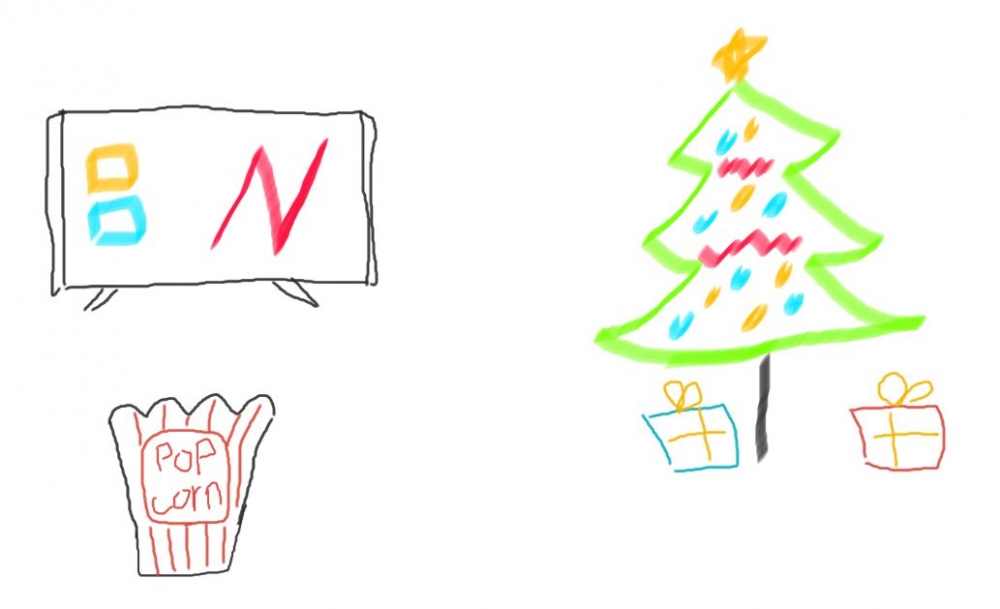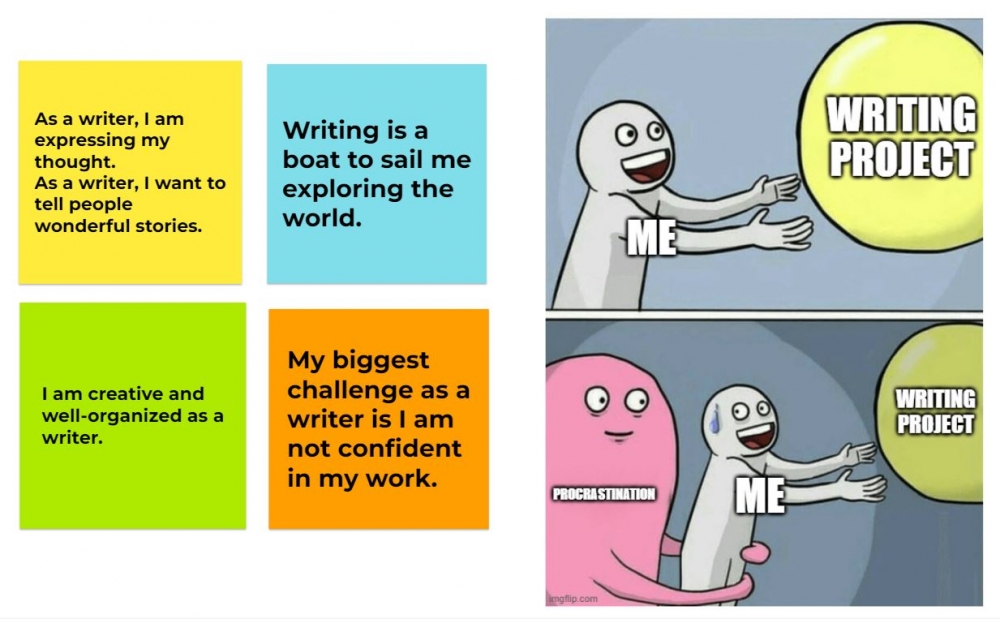Multimodal Writing in the English Language Classroom
by Danning Liang

Digital and information technology has changed
our daily communication and literacy practice. We have new forms of messages
and ways of communication in this era, commonly mixing different meaning-making
resources, such as text, images, audio, and video. Truly, the definition of
literacy has moved beyond the traditional concept.
Defining Literacy and Multiliteracies Pedagogy
With this change, multimodality has gradually been
considered a part of literacy. Multiliteracies, then, is one perspective to
better interpret literacy. To better understand this shift, we can look at the
New London Group’s (1996) suggestion: “One of the key ideas informing the
notion of multiliteracies is the increasing complexity and interrelationship of
different modes of meaning” (p. 78). Literacy is no longer restricted to
reading and writing page-bound written text; it now involves diverse
communication practices that engage multiple modes.
With this extended definition of literacy, for
effective communication, we need to consider the requirements of workplaces and
daily life where multimodality is commonly applied—this means that our literacy
education also needs to move beyond the traditional terms. Multiliteracies
pedagogy can respond to the new demands of literacy education, and embracing
multimodal composition is one way to encourage multiliteracies
pedagogy.
Incorporating Multimodal Composition in the English
Writing Classroom
As a brief definition, multimodal composition is
composition that purposefully adopts multiple modes to create meaning.
Available modes of communication include linguistic, visual, aural, gestural,
and spatial modes. Finished multimodal products involve texts that “exceed the
alphabetical and may include still and moving images, animations, color, words,
music and sound” (Takayoshi & Selfe, 2007, p. 1).
Though multimodal composition is often discussed in
the composition field, it is receiving growing attention in second language
writing studies. Research has indicated that multimodal composition can be
beneficial to English language learners. There are several reasons to embrace
multimodal composition in writing classrooms. Takayoshi and Selfe (2007)
suggest that students need to be experienced and skilled in reading and
composing multimodal texts to successfully communicate within digital
communication networks. They also suggest that changing literacy practices
should be reflected in changes in literacy education.
In addition, with multimodal composition, students’
cognitive domains and practical writing skills show positive impacts.
Multimodal composition helps motivate students in their writing and engages
them in the writing process (e.g., Zenkov et al., 2014). It also encourages
students to express identity and present creativity (e.g., Alexander et al.,
2012), and to have a sense of ownership and agency as writers. Additionally,
multimodal composition assists students with the development of their
rhetorical knowledge and writing skills (e.g., Kim & Belcher, 2020),
which includes students’ enhanced knowledge and skills to address various
rhetorical situations; understanding writing to audiences with a purpose;
paying attention to rhetorical principles of communication; and reflection on
exigence, arrangement, and rhetorical appeals.
Multimodal Writing: 2 Activities and 2 Assignments
To facilitate the benefits of multimodal
composition for English language learners, instructors can incorporate
multimodal composition in writing classrooms to help learners to (1) motivate
them to write in English, (2) be familiar with and engage in the writing
process (i.e., plan, write, revise, edit, publish), (3) pay attention to
rhetorical principles, and (4) practice multiliteracies skills. The following
are some sample activities and assignments in writing classrooms.
Activity 1: Icebreaker
Jamboard
Purpose
This activity is designed to help students
understand the concept of using modes for meaning making: Meaning can not only
be delivered through written text, but also through other modes. The activity
can be an icebreaker at the beginning of the semester, allowing students to
know more about each other. It can also be used as a warm-up activity at the
beginning of lessons.
Google
Jamboard is a useful online tool that allows students to work online
collaboratively and simultaneously. For in-person classrooms, instructors can
instead prepare markers for students to draw on whiteboards or posters.
Procedure
-
Ask students icebreaker questions, such as their
majors, habits, or career plans.
-
Students then find pictures or draw doodles to
answer the questions and add these pictures or drawings to their
Jamboard.
-
Students share their answers in class. (Figure 1
shows a sample product of answers on what students did during winter
break.)

Figure 1. Sample product of "Icebreaker
Jamboard."
Activity 2: Your Writerly Identity
Purpose
This activity is designed for students to reflect
on their literacy experience, explore their writerly identity, and practice
multimodal composition. The activity can be used as a low-stakes in-class
writing activity or a homework assignment. For this activity, you will need
access to an online meme generator.
This activity is designed for intermediate and
advanced level students who have experience and practice with English writing.
You can adapt the procedure and questions to accommodate this activity for
lower level students. You may need to prepare students prior to this activity
by teaching them about metaphors and about memes.
Procedure
-
Explain to students that they will complete four
writing tasks, including completing sentences, developing a metaphor, answering
questions, and creating a meme.
-
Have students first complete two sentences that
help them to start thinking about who they are writers:
-
As a writer, I am _____.
-
As a writer, I want to _____.
-
Then, ask students to develop and write down a
metaphor to reflect on themselves as writers and their relationship with
writing.
-
After that, have students answer these two
questions:
-
What are the strengths of your writing?
-
What do you think is the biggest challenge when
it comes to writing?
-
Have students create a meme to describe how they
feel about writing. (Figure 2 shows an example meme.)

Figure 2. Sample meme from “Your Writerly
Identity.” (Click here to enlarge)
Assignment 1: What Do You
“Meme?”
Purpose
This assignment aims to help students become
familiar with their writing process, analyze rhetorical situations, reflect on
their rhetorical choices, practice multimodal composition, and deepen their
understanding toward multimodal composition. This assignment is for advanced
level students who have background knowledge of meme creation, the writing process,
and rhetorical situations.
For this assignment, students will complete two
writing tasks: They will create a meme and they will write a reflection.
Tasks
-
Students will create a meme to reflect their
experience of or perceptions on a topic of interest. You can provide topics for
the students to choose from, such as taking final exams, recently watched TV
shows, and being on a holiday. You may also ask students questions to help them
brainstorm their meme ideas. For example: What would your life be like without
a cell phone? How does it feel if it’s the first day of school after summer
break?
-
Students reflect on their meme writing process and
rhetorical choices. Use the following writing prompts, or come up with your
own:
In your reflection, please include your answers to
the following questions.
-
What are the target/potential audiences,
purposes, and rhetorical appeals (pathos, ethos, and/or logos) of your
meme?
-
What was the design process of the meme? What are
the steps you took to create the meme?
-
What are the affordances (different strengths
and weaknesses to communicate meanings) of the meme and the use of different
modes? How will the meme help you effectively make arguments/meanings and
communicate with your readers?
Assignment 2: Multimodal Brochure
Purpose
This assignment is designed to help students to
practice multimodal composition using online digital tools; analyze rhetorical
situations that include audience, purpose, and rhetorical appeals; and pay
attention to their rhetorical choices.
For this assignment, students will create a
three-fold brochure with multiple modes.
Tasks
Students will create a three-fold brochure with
multiple modes. Tell students they can use written texts, pictures, figures,
tables, colors, video, or anything else that suits their purposes. They can use
an online brochure design tool, such as Canva, Venngage,
or VistaCreate.
Students are encouraged to select their own topics to create the brochure, but
if they would like direction, provide them with suggestions (e.g., tips on
English language learning, a travel guide, a genre comparison).
Conclusion
Multimodal composition provides additional learning
opportunities for English language learners in writing classrooms and prepares
them with multiliteracies skills to succeed in society. These multimodal
activities and assignments are some of the many ways that instructors can
incorporate multiliteracies in the classroom. By working on these activities
and assignments, students have opportunities to learn about and understand
multimodal composition as well as to practice multimodal composition.
Resources
Online Meme
Generators
Online
Whiteboard
Online Brochure Design
Tool
References
Alexander, K. P., Powell, B., & Green, S.
C. (2012). Understanding modal affordances: Student perceptions of potentials
and limitations in multimodal composition. Basic Writing
eJournal, 10(11.1). http://bwe.ccny.cuny.edu/AlexanderPowellGreenUnderstandingModalAffordances.pdf
Kim, Y., & Belcher, D. (2020). Multimodal
composing and traditional essays: Linguistic performance and learner
perceptions. RELC Journal, 51(1),
86–100.
New London Group. (1996). A pedagogy of
multiliteracies: Designing social futures. Harvard educational
review, 66(1), 60–93.
Takayoshi, P., & Selfe, C. L. (2007).
Thinking about multimodality. In C. L. Selfe (Ed.), Multimodal
composition: Resources for teachers (pp. 1–12). Hampton
Press.
Zenkov,
K., Ewaida, M., Bell, A., & Lynch, M. (2014). Picturing English
language learning youth’s and pre-service teachers’ perspectives on school: How
“Photovoice” objects might inform writing curricula and pedagogies for diverse
youth. In R. E. Ferdig & K. E. Pytash (Eds.), Exploring
multimodal composition and digital writing (pp. 332–349). IGI
Global.
Danning
Liang is a PhD candidate in composition and
applied linguistics at Indiana University of Pennsylvania (IUP). She received
her MA TESOL from Kent State University and has been enjoying tutoring and
teaching ESL learners from various backgrounds. She has years of experience of
teaching first-year composition and basic writing courses at IUP. Danning
presently works as an ESL instructor and a writing center tutor. Her research
interests include multiliteracies, multimodal composition, and collaborative
writing.